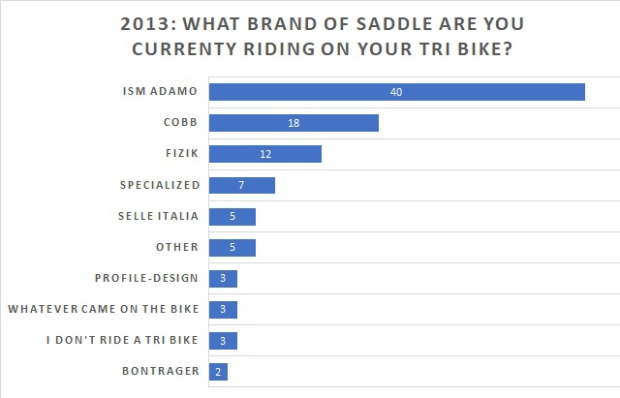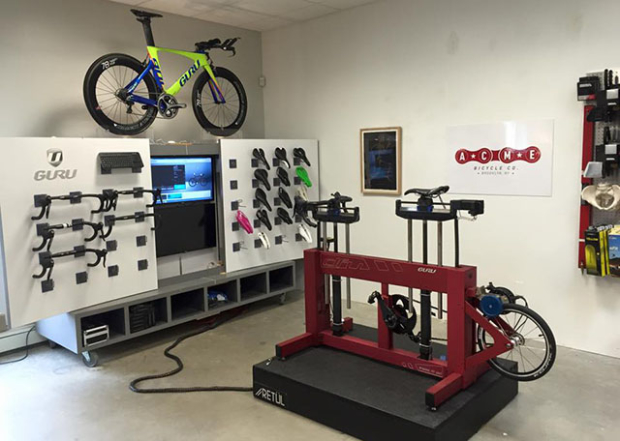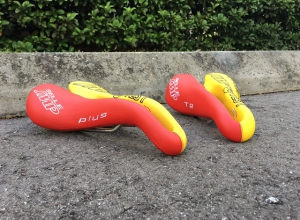You Slowtwitchers are a picky bunch when it comes to saddles, and we’re doing our best to keep track of your evolving preferences. We run regular polls in our reader forum, and have conducted no fewer than six saddle-specific polls since 2007. Our polls typically receive between about 700 and 1,500 responses, or roughly equivalent to the number of participants in a medium-to-large long course triathlon. No poll can perfectly capture the marketplace (including ours), but we have a healthy sample size and active readership – kudos to you!
This article will report on the changes that we’ve seen in terms of the brands and styles of saddles you’re choosing over time, along with comments from credible bike fitters. We’re not here to tell you what saddle to ride, but rather analyzing what you’re actually riding to find out why, and perhaps predict future trends. Note that the polls and this article are entirely gender-neutral.

Definitions
First, we must define what we’re going to be talking about. When we say “nose-less” saddle, we’re referring to a broad category of saddles such as ISM, Dash, the Fizik Mistica, and the Type 5 from Speed & Comfort (formerly the Cobb JOF 55). These saddles are all effectively missing an inch or three from the front, intending to remove soft tissue pressure when you’re rotated forward onto your aerobars.
More recently, we’ve broken these out into three sub-types: 1) Long split nose, 2) Snub single nose, and 3) Snub split nose:

Long Split Nose saddles are those like the Bontrager Hilo or the longer options from Dash. They might have a narrow ‘nose’ or bridge at the front, and/or extra area out back (on which you’re not intended to spend any significant amount of time). They give more surface area for those that want it, while largely sticking to the core design of a nose-less saddle.

Snub Single Nose saddles are those like the Fizik Mistica. They’re short, but rather than use a cutout or full-split design, they’re solid across the middle. Picture a traditional road saddle as the starting point, chop off the nose, round the edges, and you have the basic idea.

Snub Split Nose saddles are also short, and feature either a full split front, or a very deep cutout. Examples include the ISM PS series, the Type 5 from Speed and Comfort, or the short models from Dash.

Moving beyond that, some of you ride traditional road saddles on your tri bikes. These are typically long, wide at the back, narrow at the front, and may or may not include a cutout.

Finally, the newest style of saddle splits the difference between traditional and noseless saddles, often called ‘Tweener’ saddles. They’re also sometimes called Power-style saddles, because the Specialized Power saddle line became popular, sparking many similar designs from other manufacturers. These aim for a ‘best of all worlds’ design, sometimes measuring as short as noseless saddles (at ~240mm). The basic silhouette looks like a road saddle, with a wide center cutout added. This category is somewhat amorphous, so we’ll list a handful of examples that we feel make a good representation of it: Specialized Power, Shimano PRO Stealth, SMP’s T series, the Fizik Vento Argo, and the Delta M, V-Flow, or Plus 2 from Speed and Comfort (though you could argue that these last three also fit into the ‘long split nose’ category). These saddles are an increasingly common choice for road and mountain bikes, too.
Slowtwitch Poll Data
We’ll take you on a saddle journey that begins with our 2007 poll titled, “Which brand of saddle do you prefer for triathlon?”. From there, we’ll share a series of similar polls, along with basic insights about what your choices tell us.

As you can see, Fizik enjoyed a dominant market position in 2007, with near double Selle Italia’s numbers. Traditional-style saddles had a stronghold (sometimes with extra padding or a neoprene cover added), largely because nose-less style saddles were only a few years into existence for performance bikes. Noseless saddles have existed since the 80’s from brands like Hobson, but they were always odd-looking designs intended for use on upright hybrid bikes. Also note that Terry’s Butterfly saddle was one of the first widely used saddles that fits in the ‘Tweener’ category, and still sells today.

Fast forward to 2011, and Slowtwitchers had changed their tune significantly (but note that the poll above isn’t necessarily reflective of actual ownership – but rather what you think you wanted in 2011). All of a sudden, nose-less and ‘Tweener’ saddles had significant interest, with ISM and Cobb at the top of the charts. ISM exclusively makes nose-less saddles, while – in 2011 – Cobb had what we can call tweeners or long split nose, with saddles like the Plus and Max (now called the Plus 2 and Delta M).

Two years later, measuring what you actually own, ISM climbed to the top. It’s also worth noting that Specialized got in the noseless game, introducing their Sitero in 2013. We don’t know what percentage of Specialized saddles in this poll are Siteros (vs their road saddles), but we have to imagine at least a handful due to OEM spec on their own tri bikes. Fizik also introduced their Tritone noseless saddle around this time.

This brings us to today in 2019. ISM has fallen back a few percentage points, as has Cobb. The notable new introduction to the poll is Dash, who emerged as a superlight (and expensive) alternative to their comparatively hefty brethren. While Slowtwitchers tend to be more aero weenies than weight weenies – for some, weight remains a high priority. Fizik remains steady, while Specialized has climbed a bit – perhaps due to the Power saddle being introduced in 2015.
The rub is that, until now, we didn’t know the categories of saddles that you’re choosing from each manufacturer.

The poll above from this year drilled down to look at sub-types of saddles. A full half of you are choosing snub split-nose saddles, while the long split-nose and snub single-nose saddles take up the next third. Traditional road and Power/Tweener took fourth and fifth place, respectively.
Opinions and Experiences
We decided to get some professional opinions, to see how our data lines up with their experiences.

First was John Cobb of Speed and Comfort – long-time bike fitter and saddle manufacturer. We reached out to John not only because he’s a seasoned industry veteran, but also because his company is one of the only major manufacturers that sells a full variety of all saddle styles we mentioned – nose-less, tweener, and traditional (note that we reached out to two other companies that make a wide spread of saddles, and did not receive responses). During our phone conversation, John reported that he’s seeing a slight shift away from full snub/split-nose saddles, and on to more of the tweener style.
“What I do is map where people really sit on the saddles when they’re under workload… not just [spinning on a trainer]. Say at 300 watts, or something like that. Where do they [sit on the saddle]? It’s not always where we designed it for. People tend to sit further back on the seats than us designers think.”

Above image © John Cobb
He further commented that nose-less saddles aren’t a problem per se, but that there’s a big lack of awareness about the type of posture one must hold to ride them correctly: “What we find is your average consumer just doesn’t get the education [of how you have to ride a noseless seat – way off the front]. It still boils down to working with the fitters and the bike shops to get people to sit on their bikes correctly.”
Finally, he highlighted that in his experience, pressure mapping isn’t always an effective way to pick a saddle – and that your shorts can completely change how the saddle works.
“The problem with pressure mapping is that you take 10 riders and put them on a bike. They’ll go through it and say, ‘this is the seat for me.’ A pretty good percentage of the time, it’ll have the worst pressure points [of all the saddles they tried]. And then that same rider can change their shorts to a different chamois, and it’ll completely change the pressure map. The chamois and the type of shorts have a huge effect on the seat.”

Next, I corresponded with Jonathan Blyer of Acme Bicycle Co., an ace bike fitter out of New York. He said, “…in general, I think that snub/split saddles are perfectly suitable for every [triathlon] race distance and just about every athlete. There are so many options these days that if someone has a hard time with one of them there are 15 more to try. There are the very slim percentage that just won’t be happy on any saddle but I think the vast majority, when fit correctly, will be happy on a tri bike with a snub/split saddle.”
In other words, Jonathan’s view doesn’t quite line up with Mr. Cobb, instead finding that at least one of the sub-types of noseless saddles can work for any triathlete – aside from the picky few who can’t seem to settle on anything.

I also touched base with the crew from 51 Speedshop, a well-known fit operation and component manufacturer that handles bike setup for a huge number of professional triathletes and elite amateurs. Owner, Mat Steinmetz, reported, “I'm doing about 10-12 fits per month and the only time I'm not working with [a split-nose saddle] is if people are sitting higher up in the front. I have used the Power Mimic for this.”
What does this mean for YOU?
We must reiterate that polling cannot perfectly capture the market. Indeed, we’re quickly approaching the big dance in Hawaii this year, which includes its own count of bike frames, saddles, wheels, and just about every piece of equipment used by race participants. While the data is interesting, it’s only measuring the tip of the performance spear, and does not control for variables such as OEM spec of wheels, saddles, and other components that come on bikes from the factory… nor free product giveaways, sponsorship, or rental equipment (i.e. wheels).
This means that it will still come down to personal choice – especially for something as personal as saddles. We also must take bike fit into account, along with the quality of the fitters’ education and experience. Perhaps the most interesting tidbit from my conversation with John Cobb was that he considers it to be a red flag when a fitter pushes only one brand or type of saddle – even if it’s his own.
A final poll we ran in 2018 revealed that a minimum of 30% of you are still not happy on your saddles, even after trying six or more. We'll turn it over to you - have you tried all of the different saddle types - and have you found 'the one'?



